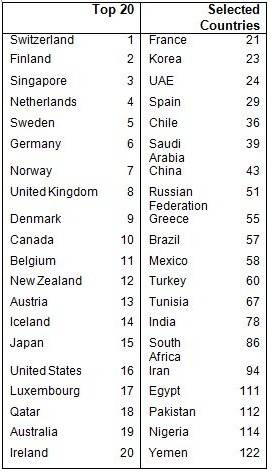The Human Capital Index, which rates countries’ success according to how good they are at maximizing the long-term economic potential of their respective workforces, has been released by the World Economic Forum.
Human capital refers to everything we invest in human beings in order to make them more productive, like education and training, skills, experience, etc.
The Index measures each country’s ability to develop and deploy healthy, well trained and able workers through four distinct pillars:
- Education
- Enabling Environment
- Health and Wellness
- Workforce and Employment
Switzerland is the top country worldwide, followed by Finland and then Singapore. Of the remaining countries in the top ten, six are in northern Europe, including the United Kingdom (8) and Germany (6). The United States is number 16 and Canada 10.

The strongest-performing country in the Middle-East and North Africa region is Qatar.
Among the BRIC countries China (43) has the highest score, followed by the Russian Federation (51), Brazil (57), India (78) and South Africa (86).
Costa Rica (35) is the top Latin-American performer, and Mauritius (47) is number one in the Sub-Saharan African region.
Egypt (111), Pakistan (112), Nigeria (114) and Yemen (122) scored at the low end of the ranking.
In Europe, northern countries fared overall better than those in the south, and western nations better than those in the East. Spain (29) had high marks for Health and wellness, but lost points in terms of Workforce and Environment (70).
In North America, Canada ranked better than the U.S. mainly because of its excellent rating for Education (number two worldwide).
The U.S. (16) excels in having a dynamic workforce and being able to attract talent, as well as a high level of university education and innovation potential.The U.S. does not score so well in Health and Wellness, due to its high levels of non-communicable diseases during prime working ages, as well as relatively low levels of mental well-being.
Japan performs well in Asia, with high scores for Health and Wellness. However the quality of education is a “persistent issue”, especially in management school. Another barrier is low levels of integration of the “silver workforce”. South Korea (23) is ranked third in Asia.
China (43) gets good points for its low unemployment and high business perceptions of skill levels. It does not score so well for Health and Wellness, the quality of its legal framework and low levels of tertiary training (college, university, etc.) in the current workforce.
While India (78) got a score of 49 for Workforce and Employment, it ranked 112 for Health and Wellness.
Qatar (18), which came top in the Middle East and North Africa, scored well on Workforce and Employment and Enabling Environment, but less so in Health and Wellness, due to high levels of non-communicable diseases. Qatar is followed by the United Arab Emirates (24), Israel (25) and Bahrain (40).
Costa Rica (35) and Chile (36) lead in Latin America, and Barbados (26) in the Caribbean. Brazil (57) loses points on Education.
A country’s human capital endowment may be more crucial for its long-term economic success than probably any other resource, the authors of the report believe.
Klaus Schwab, Founder and Executive Chairman of the World Economic Forum, said:
“The key for the future of any country and any institution lies in the skills and talent of its people. In the future, human capital will be the most important kind of capital. Investing in people is not just a nice to have; it is imperative for growth, prosperity and progress.”
Saadia Zahidi, Senior Director, Head of the Human Capital project at the World Economic Forum, said:
“Some countries face an aged or ageing population, others face youth bulges, a few even face both. For some, this means confronting a major upcoming talent crunch, while for others it means developing mechanisms that allow it to realize their population’s potential rather than letting it develop into a burden. In this light, the Human Capital Index is a tool for understanding where countries stand today so that government and business can engage in workforce planning for the future.”
